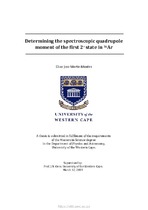| dc.description.abstract | A series of reorientation-effect Coulomb-excitation experiments
were carried out at iThemba LABS from April to May 2016.
Enriched ion beams of Ar, Ar and S were bombarded at safe
energies, well below the Coulomb barrier, onto a heavyPt target
with thickness 1mg/cm2. The three experiments were performed
to determine the spectroscopic or static quadrupole moment 𝑄, of
the first excitation 2
in these nuclei in order to shed light on the
zip-zap of nuclear shapes found at the end of the sd shell. This
thesis will be dealing with the particular case of Ar, accelerated
at a safe bombarding energy of 134.2 MeV. For this purpose, a
particle-gamma coincidence experiment has been carried out
using the AFRODITE array composed of 8 high-purity
germanium clover detectors to detect the de-exciting gamma
energies, coupled to a double-sided CD-type S3 silicon detector at
backward angles composed of 32 sectors and 24 rings to detect
the scattering particles. A new optimised sorting code has been
developed which included fast computing processing, non-Doppler
(194Pt) and Doppler correction (36Ar), add-back, and energysharing,
particle and time tagging conditions. The peaks of
interests in the spectra were analysed using the Coulombexcitation
code GOSIA. Using the normalization method, a more
precise determination of 𝑄2
0.093 eb has been
accomplished. | en_US |

